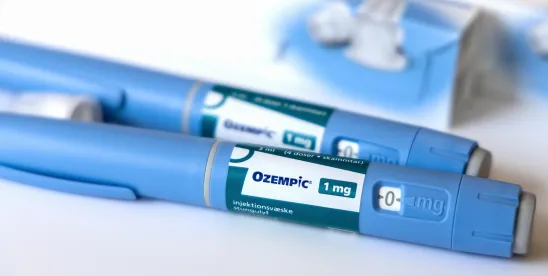The U.S. Food & Drug Administration (FDA) has approved certain GLP-1 drugs for commercialization and use, including liraglutide (Victoza®), semaglutide (Ozempic®, Wegovy®), and tirzepatide (Mounjaro®, Zepbound®). Although these drugs are FDA-approved to treat specific conditions, such as obesity or type 2 diabetes, research studies for potential additional uses and conditions, beyond obesity and diabetes, are underway.
Research for additional uses is being conducted as there is belief in the medical and scientific communities that these drugs may assist in treating a wide range of conditions, such as hypertension, addiction, heart failure, kidney disease, sleep apnea, osteoarthritis, and possibly Parkinson’s and Alzheimer’s disease. Researchers are currently exploring the potential of GLP-1 drugs to treat these conditions, and clinical trials are ongoing. A listing of GLP-1 focused clinical studies is available at ClinicalTrials.gov.
Drug Approval Process
Until a GLP-1 drug is approved by the FDA for a new patient population or new condition, any prescription for the use of the drug for a condition or with a patient that is not contemplated within the FDA-approved labeling is and is considered “off label” prescribing. Drug manufacturers may not promote the drug for an “off-label” use. Any prescription of a drug for an “off-label” use must be made at the sole discretion and professional medical judgment of the prescribing physician. The off-label status may impact some patient coverage and claim reimbursement determinations even though the drug is approved by FDA for at least one other (label) use.
Applicants must submit a New Drug Application (NDA) to the FDA to receive FDA approval to market a drug for a new intended use or indication for use, such as a new specific patient population. Before a drug can legally be marketed for a new intended use or indication for use (e.g., new patient population), the safety and efficacy of the new intended use or indication for use must be demonstrated through well-controlled clinical trials.
New drugs must typically pass through three clinical trial phases before being considered by FDA for approval:
- Phase 1 – Small number of healthy test subjects; assessing safety and dosage.
- Phase 2 – Larger group of test subjects afflicted with the disease or condition being studied; evaluating effectiveness and safety.
- Phase 3 – Larger group of test subjects often across multiple locations; confirming effectiveness, monitoring side effects, and comparing the new treatment to standard of care.
- Phase 3 studies are typically designed as randomized, double-blind, placebo-controlled trials, which means that neither the participants nor the researchers know which treatment each participant is receiving.
Conducting clinical trials takes considerable time, effort, and resources. Obtaining drug approval via the traditional NDA pathway can take years (often up to 15 years) and cost millions of dollars.
Clinical Trial Design for Accelerated Drug Approval
Despite the exciting potential for GLP-1 drugs to treat a range of conditions beyond obesity and diabetes, obtaining drug approval for new indications for use remains a daunting task due to the considerable time, effort, and resources required to conduct the necessary clinical trials. Fortunately, FDA offers an accelerated drug approval pathway that may be helpful for applicants developing new uses and indications for already approved drugs, such as FDA-approved GLP-1 drugs.
The 505(b)(2) NDA pathway provides a streamlined route for drug approval that allows FDA to consider pre-existing data when reviewing an NDA for a new indication of use — even if the applicant did not develop the data themselves.
This pathway accelerates the approval process and reduces costs because applicants may include data from external studies to establish the safety and efficacy of the already FDA-approved active ingredient. Applicants must still supply their own data, such as research results, that support the new indication for use, but they may also rely on existing data demonstrating what is already known about the previously approved drug.
When designing clinical trials to support new indications for use of FDA-approved GLP-1s, applicants should:
- Consider ways to leverage existing data (e.g., public data or previous FDA findings) to reduce the size, scope, timeline, and cost of development.
- Conduct comprehensive literature reviews to find publicly available data.
- Develop studies that are intended to successfully bridge what is already known about the drug and the proposed modification to the drug.
- Work closely with the FDA via meetings such as the pre-investigational new drug (IND) phase meetings, Type C meetings, and pre-NDA meetings to gain the FDA’s input regarding the scope of its proposed studies.
- Carefully evaluate exclusivity periods and patenting/marketing strategies.
Because of the increased requirements applicable to these types of studies, it is critical that companies conducting these studies carefully structure their drug development programs to ensure that all studies are appropriately capturing the level of detail and thoroughness which FDA will require when reviewing an NDA. It is imperative that these companies maintain a strong working relationship with FDA throughout this process; stay informed regarding any new guidance that may impact this unique drug class; pay careful attention when negotiating clinical trial agreements to ensure all clinical data, information, and results are protected, confidential, and owned by the sponsor; and establish strong compliance programs to ensure that the company, as a clinical trial sponsor, meets all quality system and other FDA requirements.






 />i
/>i
